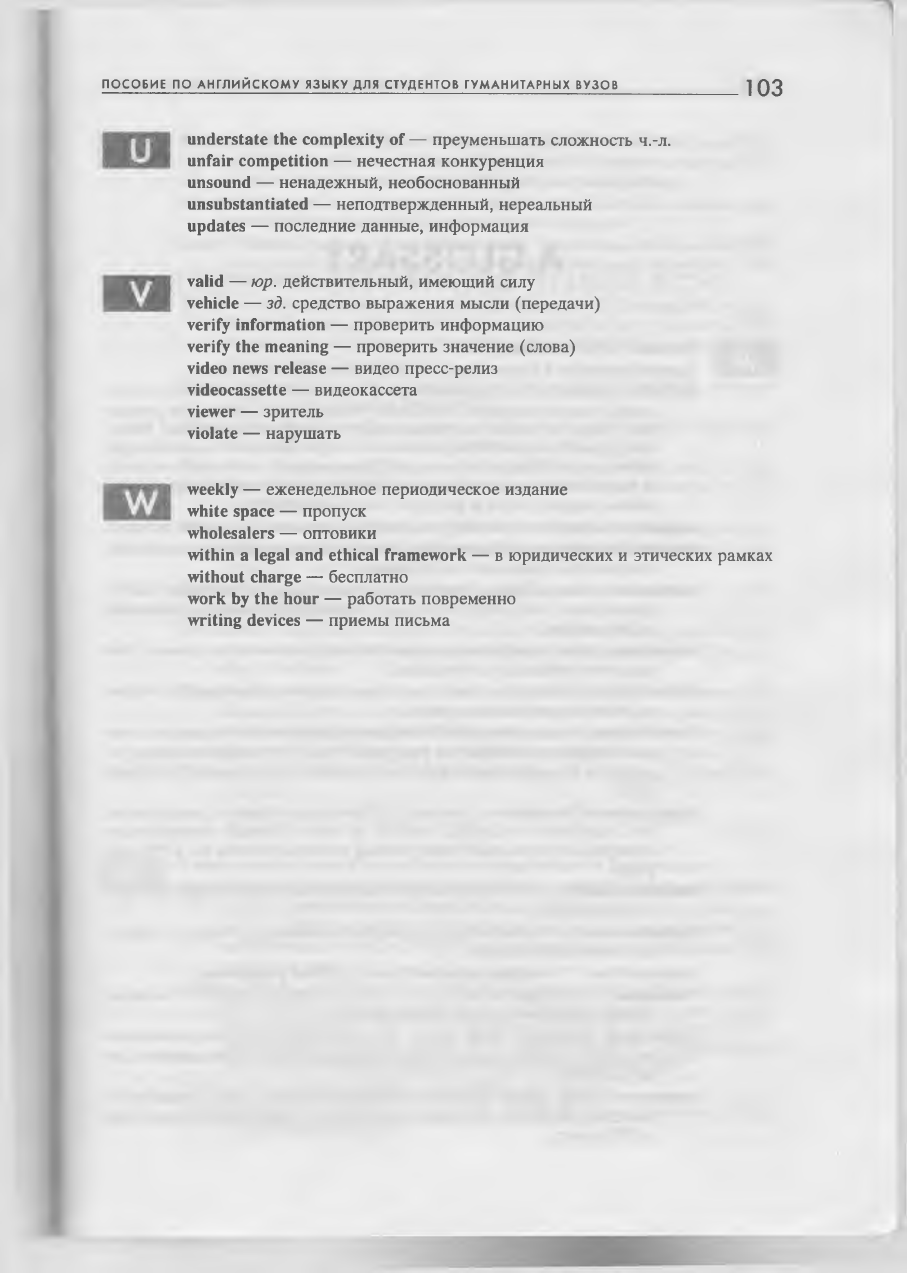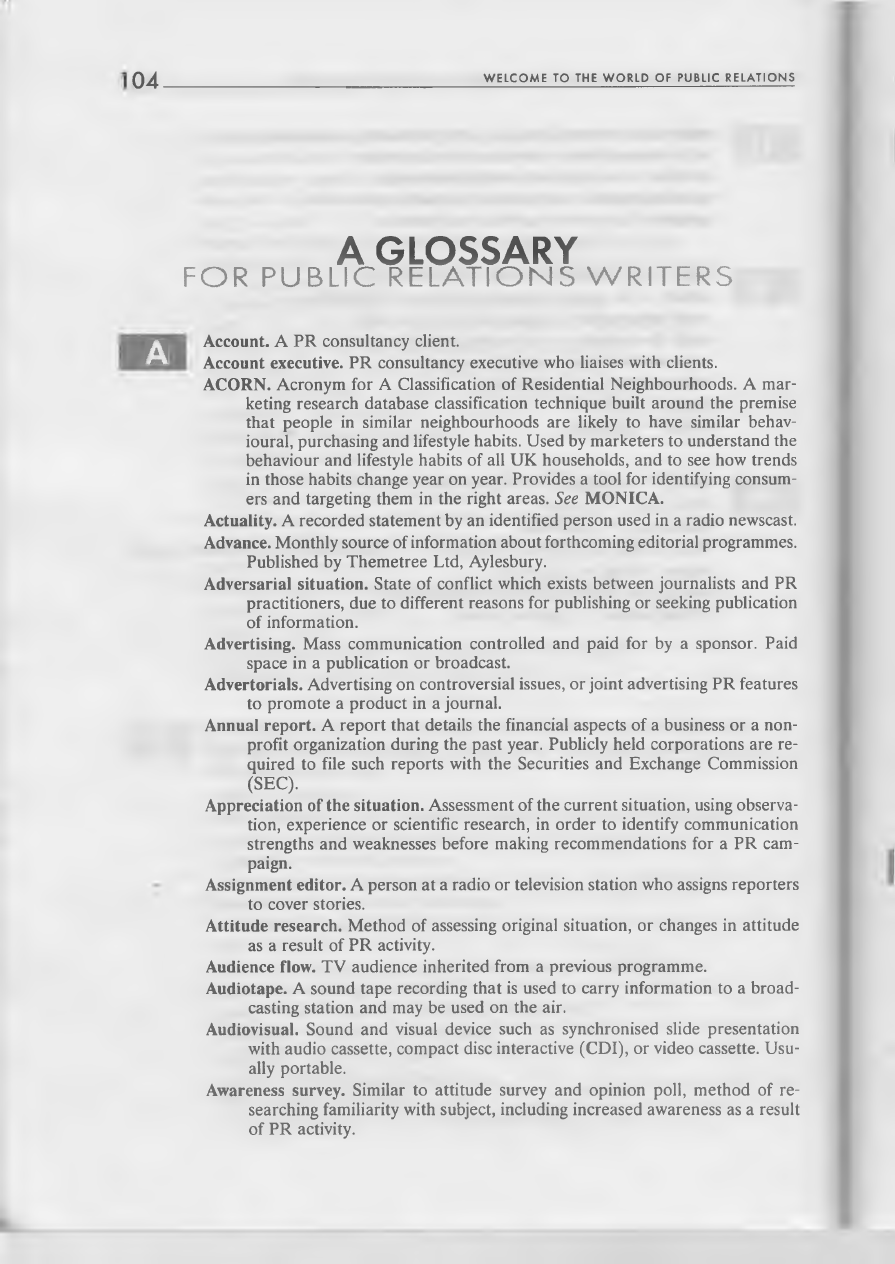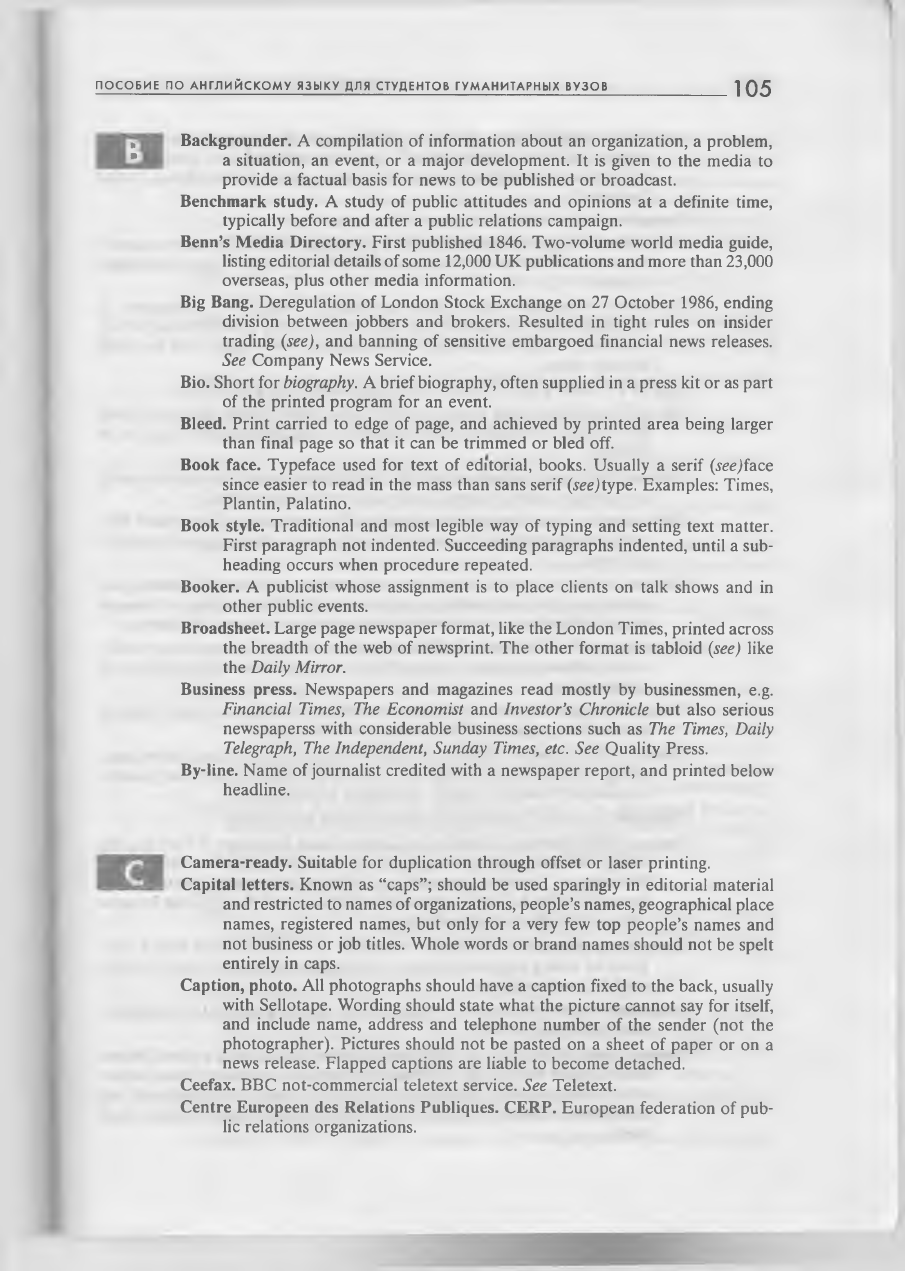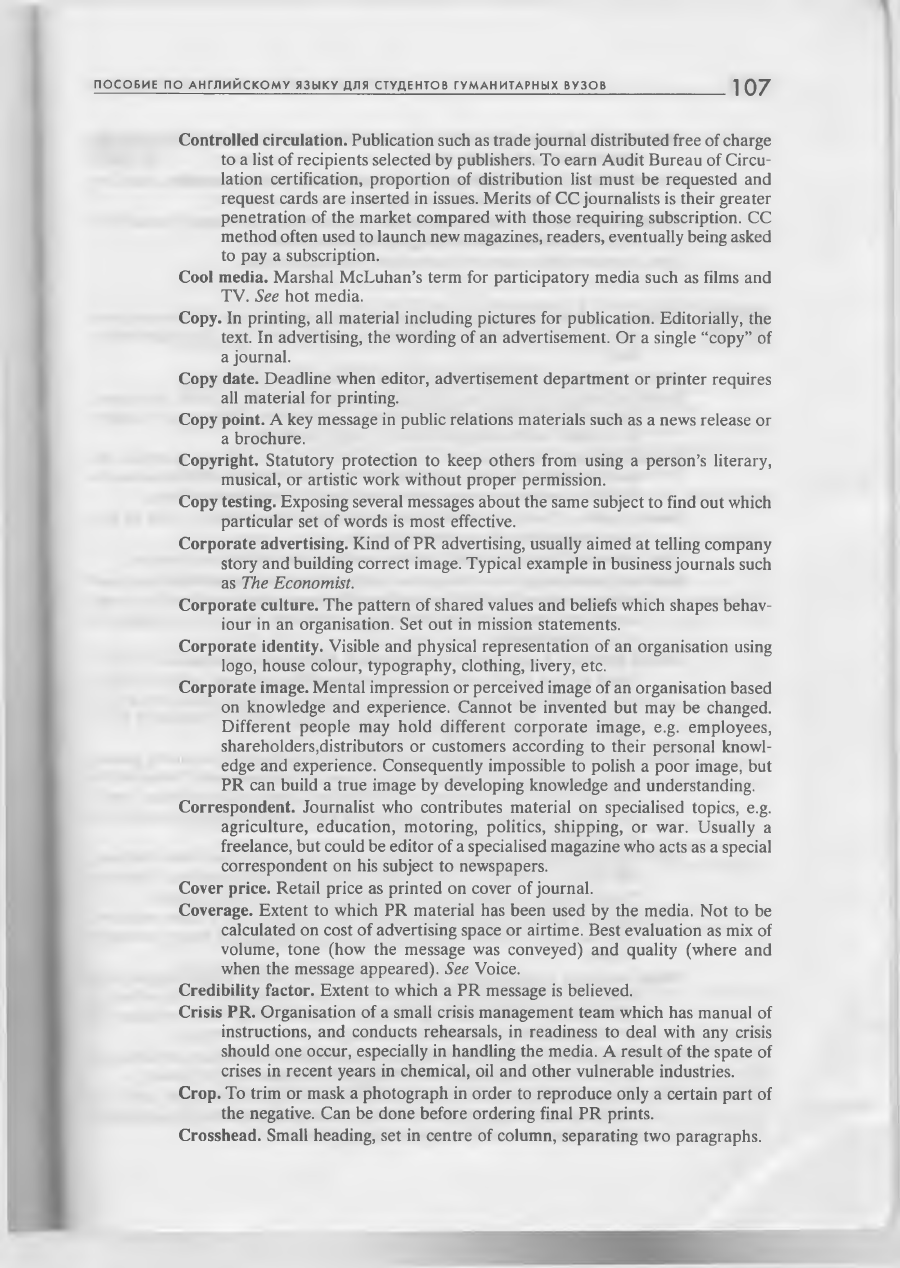ВУЗ: Не указан
Категория: Не указан
Дисциплина: Не указана
Добавлен: 01.04.2021
Просмотров: 1566
Скачиваний: 7

П О С О Б И Е П О А Н Г Л И Й С К О М У Я З Ы К У Д Л Я С Т У Д Е Н Т О В Г У М А Н И Т А Р Н Ы Х В У З О В
103
understate the complexity of
— преуменьшать сложность ч.-л.
unfair competition
— нечестная конкуренция
unsound
— ненадежный, необоснованный
unsubstantiated
— неподтвержденный, нереальный
updates
— последние данные, информация
valid
—
юр.
действительный, имеющий силу
vehicle
—
зд.
средство выражения мысли (передачи)
verify information
— проверить информацию
verify the meaning
— проверить значение (слова)
video news release
— видео пресс-релиз
videocassette
— видеокассета
viewer
— зритель
violate
— нарушать
weekly
— еженедельное периодическое издание
white space
— пропуск
wholesalers
— оптовики
within a legal and ethical framework
— в юридических и этических рамках
without charge
— бесплатно
work by the hour
— работать повременно
writing devices
— приемы письма

04
W E L C O M E TO THE W O R L D O F PUBLI C R E L A T I O N S
A GLOSSARY
F O R P U B L I C R E L A T I O N S W R I T E R S
A
Account. A PR consultancy client.
Account executive. PR consultancy executive who liaises with clients.
ACORN. Acronym for A Classification of Residential Neighbourhoods. A mar
keting research database classification technique built around the premise
that people in similar neighbourhoods are likely to have similar behav
ioural, purchasing and lifestyle habits. Used by marketers to understand the
behaviour and lifestyle habits of all UK households, and to see how trends
in those habits change year on year. Provides a tool for identifying consum
ers and targeting them in the right areas.
See
MONICA.
Actuality. A recorded statement by an identified person used in a radio newscast.
Advance. Monthly source of information about forthcoming editorial programmes.
Published by Themetree Ltd, Aylesbury.
Adversarial situation. State of conflict which exists between journalists and PR
practitioners, due to different reasons for publishing or seeking publication
of information.
Advertising. Mass communication controlled and paid for by a sponsor. Paid
space in a publication or broadcast.
Advertorials. Advertising on controversial issues, or joint advertising PR features
to promote a product in a journal.
Annual report. A report that details the financial aspects of a business or a non
profit organization during the past year. Publicly held corporations are re
quired to file such reports with the Securities and Exchange Commission
(SEC).
Appreciation of the situation. Assessment of the current situation, using observa
tion, experience or scientific research, in order to identify communication
strengths and weaknesses before making recommendations for a PR cam
paign.
Assignment editor. A person at a radio or television station who assigns reporters
to cover stories.
Attitude research. Method of assessing original situation, or changes in attitude
as a result of PR activity.
Audience flow. TV audience inherited from a previous programme.
Audiotape. A sound tape recording that is used to carry information to a broad
casting station and may be used on the air.
Audiovisual. Sound and visual device such as synchronised slide presentation
with audio cassette, compact disc interactive (CDI), or video cassette. Usu
ally portable.
Awareness survey. Similar to attitude survey and opinion poll, method of re
searching familiarity with subject, including increased awareness as a result
of PR activity.

щ
т
П О С О Б И Е П О А Н Г Л И Й С К О М У Я З Ы К У Д Л Я С Т У Д Е Н Т О В Г У М А Н И Т А Р Н Ы Х В У З О В
105
Backgrounder. A compilation of information about an organization, a problem,
a situation, an event, or a major development. It is given to the media to
provide a factual basis for news to be published or broadcast.
Benchmark study. A study of public attitudes and opinions at a definite time,
typically before and after a public relations campaign.
Benn’s Media Directory. First published 1846. Two-volume world media guide,
listing editorial details of some 12,000 UK publications and more than 23,000
overseas, plus other media information.
Big Bang. Deregulation of London Stock Exchange on 27 October 1986, ending
division between jobbers and brokers. Resulted in tight rules on insider
trading
(see),
and banning of sensitive embargoed financial news releases.
See
Company News Service.
Bio. Short for
biography.
A brief biography, often supplied in a press kit or as part
of the printed program for an event.
Bleed. Print carried to edge of page, and achieved by printed area being larger
than final page so that it can be trimmed or bled off.
Book face. Typeface used for text of editorial, books. Usually a serif (ree)face
since easier to read in the mass than sans serif
(see)
type. Examples: Times,
Plantin, Palatino.
Book style. Traditional and most legible way of typing and setting text matter.
First paragraph not indented. Succeeding paragraphs indented, until a sub
heading occurs when procedure repeated.
Booker. A publicist whose assignment is to place clients on talk shows and in
other public events.
Broadsheet. Large page newspaper format, like the London Times, printed across
the breadth of the web of newsprint. The other format is tabloid
(see)
like
the
Daily Mirror.
Business press. Newspapers and magazines read mostly by businessmen, e.g.
Financial Times, The Economist
and
Investor’s Chronicle
but also serious
newspaperss with considerable business sections such as
The Times, Daily
Telegraph, The Independent, Sunday Times, etc. See
Quality Press.
By-line. Name of journalist credited with a newspaper report, and printed below
headline.
Camera-ready. Suitable for duplication through offset or laser printing.
Capital letters. Known as “caps”; should be used sparingly in editorial material
and restricted to names of organizations, people’s names, geographical place
names, registered names, but only for a very few top people’s names and
not business or job titles. Whole words or brand names should not be spelt
entirely in caps.
Caption, photo. All photographs should have a caption fixed to the back, usually
with Sellotape. Wording should state what the picture cannot say for itself,
and include name, address and telephone number of the sender (not the
photographer). Pictures should not be pasted on a sheet of paper or on a
news release. Flapped captions are liable to become detached.
Ceefax. BBC not-commercial teletext service.
See
Teletext.
Centre Europeen des Relations Publiques. CERP. European federation of pub
lic relations organizations.

106
W E L C O M E TO THE W O R L D O F PUBLI C R E L A T I O N S
Centrefold spread. Centre spread or middle pages of a journal which can be
opened flat if not “perfect bound”, that is wire-stitched
{see).
Usually print
ed right across both pages, permitting large pictures and headlines. Called
“naturals”.
Character. Single letter, digit or symbol in typesetting.
Circulation. Average audited net sale of a journal, as certified in many countries
by an Audit Bureau of Circulations which issues ABC figures at regular
intervals.
City editor or business editor. Edits the financial section of a newspaper. In
London, offices are in the City and separate from main editorial office.
However, in some countries the chief editor or news editor may be called
the city editor.
Clip. In TV, short piece of film or videotape shown during a live show.
Clip art. Line art and other graphic designs in the public domain that can be used
for a variety of purposes. Such material is available in print form or on
diskette.
Clubline. First line of a paragraph at the foot of page, rest of paragraph running
on to next column or page. Can be ugly and is best avoided.
CNN. American-based international satellite TV news service Cable News Net
work, which provides live news of world events including crisis situations
and wars.
Cold-set. Drying of print on the machine without heat. Achieved by printing one
colour at a time and feeding in sheets again for other colours, or because
paper is absorbent, or with wet-on-wet printing of colours.
See
heat-set.
Colour separation. Separation of full-colour pictures into four separate process
colour, yellow, magenta, cyan and black , by computer or optical filters, for
platemaking.
Column. A regular feature in a publication written by a columnist, also, a vertical
stack of text, separated from the next by white space.
Column inch/centimetre. Measure of depth of column space as used when mea
suring press media coverage. However, this volume is only one possible
assessment. Tone and quality of coverage also important.
Columnist. Journalist who writes a regular feature with by-line.
Company News Service. Introduced by London Stock Exchange in 1985
(see
Big
Bang) and linked with trading floors in Birmingham, Dublin, Glasgow and
Manchester. Receives, prepares and releases information electronically.
Stock Exchange booklet
Company News Services
lays down format for news
releases and discourages embargoes.
Computer graphics. Post-production technique of drawing designs with a com
puter for taping and transference to video tapes.;
See
also Paintbox. Can be
used for making slides.
Condensed. Narrow version of a typeface. Can also be generated by computer
ised typesetting software.
Contact report. Written by account executive after meeting with a client. Should
state decision taken, with right-hand column giving initials of those respon
sible for next action. Distributed to all relevant parties on consultancy and
client sides. Also known as call report. File of reports called the facts book
(see).

П О С О Б И Е П О А Н Г Л И Й С К О М У Я З Ы К У Д Л Я С Т У Д Е Н Т О В Г У М А Н И Т А Р Н Ы Х В У З О В
107
Controlled circulation. Publication such as trade journal distributed free of charge
to a list of recipients selected by publishers. To earn Audit Bureau of Circu
lation certification, proportion of distribution list must be requested and
request cards are inserted in issues. Merits of CC journalists is their greater
penetration of the market compared with those requiring subscription. CC
method often used to launch new magazines, readers, eventually being asked
to pay a subscription.
Cool media. Marshal McLuhan’s term for participatory media such as films and
TV.
See
hot media.
Copy. In printing, all material including pictures for publication. Editorially, the
text. In advertising, the wording of an advertisement. Or a single “copy” of
a journal.
Copy date. Deadline when editor, advertisement department or printer requires
all material for printing.
Copy point. A key message in public relations materials such as a news release or
a brochure.
Copyright. Statutory protection to keep others from using a person’s literary,
musical, or artistic work without proper permission.
Copy testing. Exposing several messages about the same subject to find out which
particular set of words is most effective.
Corporate advertising. Kind of PR advertising, usually aimed at telling company
story and building correct image. Typical example in business journals such
as
The Economist.
Corporate culture. The pattern of shared values and beliefs which shapes behav
iour in an organisation. Set out in mission statements.
Corporate identity. Visible and physical representation of an organisation using
logo, house colour, typography, clothing, livery, etc.
Corporate image. Mental impression or perceived image of an organisation based
on knowledge and experience. Cannot be invented but may be changed.
Different people may hold different corporate image, e.g. employees,
shareholders,distributors or customers according to their personal knowl
edge and experience. Consequently impossible to polish a poor image, but
PR can build a true image by developing knowledge and understanding.
Correspondent. Journalist who contributes material on specialised topics, e.g.
agriculture, education, motoring, politics, shipping, or war. Usually a
freelance, but could be editor of a specialised magazine who acts as a special
correspondent on his subject to newspapers.
Cover price. Retail price as printed on cover of journal.
Coverage. Extent to which PR material has been used by the media. Not to be
calculated on cost of advertising space or airtime. Best evaluation as mix of
volume, tone (how the message was conveyed) and quality (where and
when the message appeared).
See
Voice.
Credibility factor. Extent to which a PR message is believed.
Crisis PR. Organisation of a small crisis management team which has manual of
instructions, and conducts rehearsals, in readiness to deal with any crisis
should one occur, especially in handling the media. A result of the spate of
crises in recent years in chemical, oil and other vulnerable industries.
Crop. To trim or mask a photograph in order to reproduce only a certain part of
the negative. Can be done before ordering final PR prints.
Crosshead. Small heading, set in centre of column, separating two paragraphs.